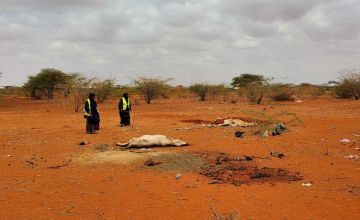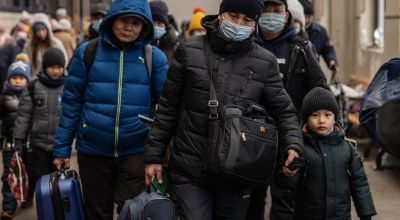
Knowledge Hub
People all over the UK and Europe are feeling the pinch, whether that’s due to rising energy bills, inflation or petrol prices creeping up. Anecdotes about the cost of pasta going up in shops and the eye-watering price of a shower on your smart meter are constantly being swapped, and that was before the conflict in Ukraine began to have an effect on the cost of living.
Transport issues and the region’s contribution to food and energy supplies have meant that Europe is feeling the strain. But this effect is rippling out far beyond the continent, and is having a devastating impact further afield.
Food insecurity is set to become an even more worrying trend, with 1.7 billion people at risk of increased poverty due to the crisis – one that was already brewing prior to the conflict.
What effect is the Ukraine crisis having on the rest of the world?
Millions of people in Ukraine have been displaced by conflict, whether that’s being forced to flee the country or leave their homes within Ukraine. Those who have left face an uncertain future, those who stayed are struggling to find shelter and food, and to avoid danger. The world has watched in horror and many have been affected by the plight of Ukrainians, but the conflict is having a ripple effect on the daily lives of people thousands of miles away.


Ukraine and the Russian Federation are among the world’s “breadbaskets”, in that they provide around 30% of the world’s wheat and barley. Thirty-six countries import more than 50% of their wheat from Russia and Ukraine, including Pakistan, Somalia, Lebanon, Turkey, Democratic Republic of Congo, Rwanda, Sudan and Burundi – all countries that Concern Worldwide works in. For example, Sudan, which has become particularly vulnerable, imports 86-87% of its wheat from Russia and Ukraine.
In addition to its wheat and barley supplies, the region provides one fifth of the world’s maize and over half of the world’s sunflower oil, which is primarily used for cooking. The Russian Federation is also the world’s top natural gas exporter and second largest oil exporter, and alongside neighbouring Belarus, exports a fifth of the world’s fertilisers.
The conflict in Ukraine means that there have been spikes in commodity prices and disrupted supply chains. This results in a lack of resources for poorer countries depending on wheat from the region, for example, and anything available is rocketing in price.

Just two months after the conflict began, this is having a dire effect on already struggling communities. Somalia, which relies on Ukraine and Russia for nearly 90% of its wheat, is already struggling with a devastating drought, which has killed livestock across the country and is decimating access to water, food and income. Meanwhile, in Sierra Leone, according to AFP, a 50kg bag of rice which previously cost around €27 has risen to €32 – an increase of around 20%. In addition, at the end of March, Sierra Leone's Petroleum Regulatory Agency (PRA) increased the ceiling prices for petrol and diesel by 34% and 40% respectively compared to January, citing the “deteriorating geopolitical situation in Europe” as the reason.
On the 8th of April 2022, the United Nations Food and Agriculture Organisation (FAO) published its third record food price index, and noted that food prices are 34% higher than this time last year. And with crude oil and gas prices also rising, it is too expensive to transport goods – creating another barrier to nutrition.
“A perfect storm”
This situation would be difficult in any circumstances, but rising food prices are coming after a series of challenges that have already increased prices, reduced income and exacerbated instability.
The Covid-19 pandemic has caused six million deaths worldwide, and while vaccine take-up has been high in many nations, we still don’t have vaccine equality in developing countries.
According to the United Nations Task Team for the Global Crisis Response Group (UNGCRG), school closures as a result of the pandemic have led to losses of up to 17 trillion dollars in lifetime earnings for this generation of students. In addition, since 2019, the number of people experiencing hunger has increased by 46 million in Africa, around 57 million in Asia, and around 14 million more in Latin America and the Caribbean, and an additional 77 million more people are living in extreme poverty. Meanwhile, climate change is also impacting the lives and work of millions, with pastoralists struggling to recover from weather shocks and access the resources needed to adapt.


It is expected that 1.7 billion people – 553 million of which are already poor, and 215 million are already undernourished – are severely exposed to at least one of the Ukraine crisis’s three global channels of transmission: rising food prices, rising energy prices and tightening financial conditions. That is one fifth of humanity.
However, among that number, there are 1.2 billion people in 69 economies who are particularly vulnerable to all three channels of transmission, for whom the crisis will be even more devastating.
We are now facing a perfect storm that threatens to devastate the economies of developing countries.
According to United Nations secretary-general Antonio Guterres, the UNGCRC’s report on the global impact of the Ukraine crisis on food, energy and finance systems “shows that there is a direct correlation between rising food prices and social and political instability. Our world cannot afford this. We need to act now.”
What can be done?
The UNGCRG report outlines a number of policy recommendations, urging the world to act with urgency to help those most affected. Under their food policy recommendations, there are five suggestions for world governments to consider.
To ensure sufficient supplies of nutritious food available for all people
This involves ensuring that food supplies are available, including diversifying sources of supply in import-reliant countries, reducing loss and waste of food throughout supply chains, enabling smaller food producers to maintain their livelihoods and contribute to food production, and keeping freight prices stable. Countries with large food stocks are also asked to support countries in need.
To enable all vulnerable people to access and make use of the food they need
To enable all people everywhere to access humanitarian food assistance when necessary
To adopt sound policy responses based on local need, national priorities and evolving market conditions
Access to finance
What Concern are doing
Our vision, our mission and our work are all defined by one goal – ending extreme poverty, whatever it takes. Our teams on the ground are working together with people living in the most difficult situations, rebuilding and transforming lives, livelihoods and communities.
For over 50 years, we’ve been developing and delivering practical, intelligent, sustainable solutions to tackle hunger in the world’s poorest places - combining our expertise with local knowledge. One way we respond is to support health and nutrition centres in some of the hardest-to-reach areas, and during times when hunger levels are at their worst. Our pioneering Community Management of Acute Malnutrition (CMAM) approach funds clinics that provide essential maternal and childhood healthcare for severely malnourished babies and young children, giving children weekly medical treatment and therapeutic food.
Another approach is through our range of livelihood programmes. Across the globe, these programmes give people the tools to improve animal help and productivity, seeds and materials to build vegetable gardens at home or agricultural vouchers that enable farming households to buy tools and seeds that will increase their harvest.
Other ways to help
Donate now
Give a one-off, or a monthly, donation today.
Join an event
From mountain trekking to marathon running, join us for one of our many exciting outdoor events!
Buy a gift
With an extensive range of alternative gifts, we have something to suit everybody.
Leave a gift in your will
Leave the world a better place with a life-changing legacy.
Become a corporate supporter
We partner with a range of organisations that share our passion and the results have been fantastic.
Create your own fundraising event
Raise money for Concern by organising your own charity fundraising event.





